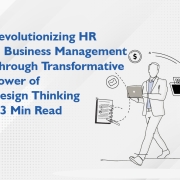Revolutionizing HR in Business Management Through Transformative Power of Design Thinking – 3 Min Read
The integration of Design Thinking into HR marks a shift in contemporary business management, reshaping organizational growth dynamics. Design Thinking, rooted in empathy, observation, and iterative problem-solving, offers a novel lens to tackle intricate HR challenges. Its transformative impact lies in understanding human preferences, trends, and the evolving landscape of technology that shapes HR practices. This methodology employs a cyclical process encompassing understanding, observation, empathy, problem definition, ideation, prototyping, and testing. In the modern business landscape, employees have emerged as key drivers of innovation, shaping the efficiency of Human Resource Management Systems This trend fuels the development of cutting-edge products & services streamlining HR processes while cultivating an engaging work culture to curb job dissatisfaction and attrition. The amalgamation of emerging technologies further propels HR practices, ensuring adaptability in a globalized, hyper-personalized workspace.
Students, immersed in this approach, underwent phases of Design Thinking & teams came up with:
How might we reduce the job dissatisfaction and attrition in the organization?
Solution: They created training modules at three different levels. Came up with module timeline and app creation for stress management. Thus, making more resources available, stress relieving techniques and clear usage of technology intervention.
How might we develop a comprehensive employee value proposition to create more engaging and innovative work culture?
Solution: The team created prototypes based on Gartner’s framework where they brought about gamified onboarding, proposed an EVP, created values in the game like organization, department overview and CGMP training, where booklets for new employees, digital documentation came in and HR policies as game rules were explained.
How might we lead to performance enhancement of work force (client centric workforce) by 10%
Solution: The team talked with the client work team -> co-ordinated with the development team. They brought internal teams together. Four generations working under the same roof. Where the mental models were studied of various generations related to professional work, environment, team work, suggestions of clarity on expectations, transparency among all generations.
Solution: They brought about transparency and awareness among all The following results were derived after a detailed conversation with the students:
- Improved creativity and ability to generate innovative ideas.
- Strengthened teamwork, facilitating the maximization of each team member’s potential.
- Implemented structure and organization in project development -> execution.
- Instilled a human-centric approach to problem-solving.
- Enhanced cognitive flexibility, problem identification, creative problem-solving abilities.
- Developed the capacity to function cohesively and effectively as a team.
- Significance of active listening, observation, and embracing diverse perspectives for a comprehensive understanding of organizational challenges.
- Applied unconventional thinking to generate unique effective solutions.
- Effectively presenting project proposals to stakeholders, articulating the core problem and the proposed solution.
- Applicability of design thinking as a problem-solving tool in various aspects, including professional settings, academic environments, everyday situations, emphasizing its promotion of divergent & lateral thinking skills.



